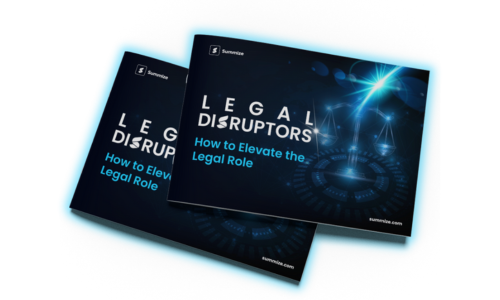The Legal Ops Podcast: Talking Tech
In this Legal Ops 'Talking Tech' episode, Alex and Elliot interview Tom Dunlop, CEO of Summize, to talk about how Summize is pioneering change for legal teams.
February 10, 2021
December 19, 2025
The Legal Ops Podcast, hosted by Alex Rosenrauch and Elliot Leibu, explores the legal technology landscape by speaking directly with founders and leaders behind innovative tools. Each episode focuses on understanding what these technologies do, who they are built for, and how they deliver real value to legal teams.
In this episode, Alex and Elliot are joined by Summize’s CEO and Co-founder Tom Dunlop. Tom is a lawyer by background, having worked both in private practice and as an in-house legal director for fast-growing software companies. Through that experience, he saw first-hand the pain points lawyers face when reviewing, managing, and understanding contracts at speed. Those frustrations ultimately led to the creation of Summize, a lightweight contract review and contract lifecycle management assistant designed to fit naturally into how lawyers already work.
A lawyer-led origin story
One of the defining aspects of Summize is that it was built by someone who was the end user. Tom explains that his move from in-house legal roles into founding a legal technology company was driven by a clear gap in the market. Existing tools were often expensive, complex, and required lawyers to radically change their behavior or move away from familiar tools like Microsoft Word.
Summize was designed with a different philosophy: keep it lightweight, easy to adopt, and fast to deliver value. Rather than forcing lawyers to learn an entirely new way of working, the product fits into existing workflows. This user-first approach underpins many of Summize’s design decisions and explains why adoption and time to value are such a strong focus.
Lightweight contract review inside Word
A major topic of discussion is Summize’s Microsoft Word add-in, which allows lawyers to review contracts directly where they already spend most of their time. With a single click, users can generate summaries of contracts, navigate quickly to relevant clauses, and view or edit definitions without endlessly scrolling.
The add-in also allows lawyers to incorporate their own playbooks and precedent clauses. Rather than performing full clause swaps, users can make granular edits to specific parts of third-party paper, such as payment terms or invoicing requirements. This approach reflects the reality of contract negotiation, where flexibility matters more than rigid “your precedent versus theirs” comparisons.
The result is faster comprehension, quicker mark-ups, and less cognitive fatigue during high-volume contract review.
Pre- and post-signature contract understanding
Another key theme is Summize’s ability to support both pre-signature and post-signature use cases. Pre-signature, the tool accelerates contract review, redlining, and negotiation. Post-signature, it becomes a lightweight contract management system.
Once agreements are signed, contracts can be stored in the Summize web application, where key terms such as renewal dates are automatically extracted and surfaced through calendars and insights. Users can ask questions of their contracts, such as how to terminate an agreement or when obligations begin, and receive clear, targeted answers.
Importantly, these questions can be asked not only of individual contracts but across entire contract repositories, making Summize useful for due diligence exercises, regulatory reviews, or risk assessments across large volumes of agreements.
Augmenting lawyers, not replacing them
Throughout the conversation, Tom is clear that Summize is designed to augment legal teams rather than replace them. While the technology enables self-service for certain low-risk, high-volume questions, it deliberately keeps lawyers in control of how clauses, questions, and outputs are defined.
This balance allows legal teams to act as a front door for the business. Non-legal stakeholders can get faster answers to common questions, while lawyers focus their time on higher-value, strategic work. For law firms, this also opens the door to new service models, where clients are given controlled access to contract insights as part of a broader advisory offering.
From a return-on-investment perspective, the benefits range from direct time savings to reduced contract leakage and improved business decision-making, all supported by a pricing model designed to be accessible to mid-market firms and in-house teams.
Listen to the full episode
If you’re interested in how contract review, management, and insight generation can be streamlined without heavy implementation or disruptive change, this episode offers a practical and grounded perspective. To hear the full discussion, including real-world use cases and implementation advice, be sure to listen to the complete Legal Ops Podcast episode at the start of the article, and to hear more of our insights, explore our useful articles and guidance below.
Discover even more!
Explore more about contracting and CLM in our ultimate contract guides








